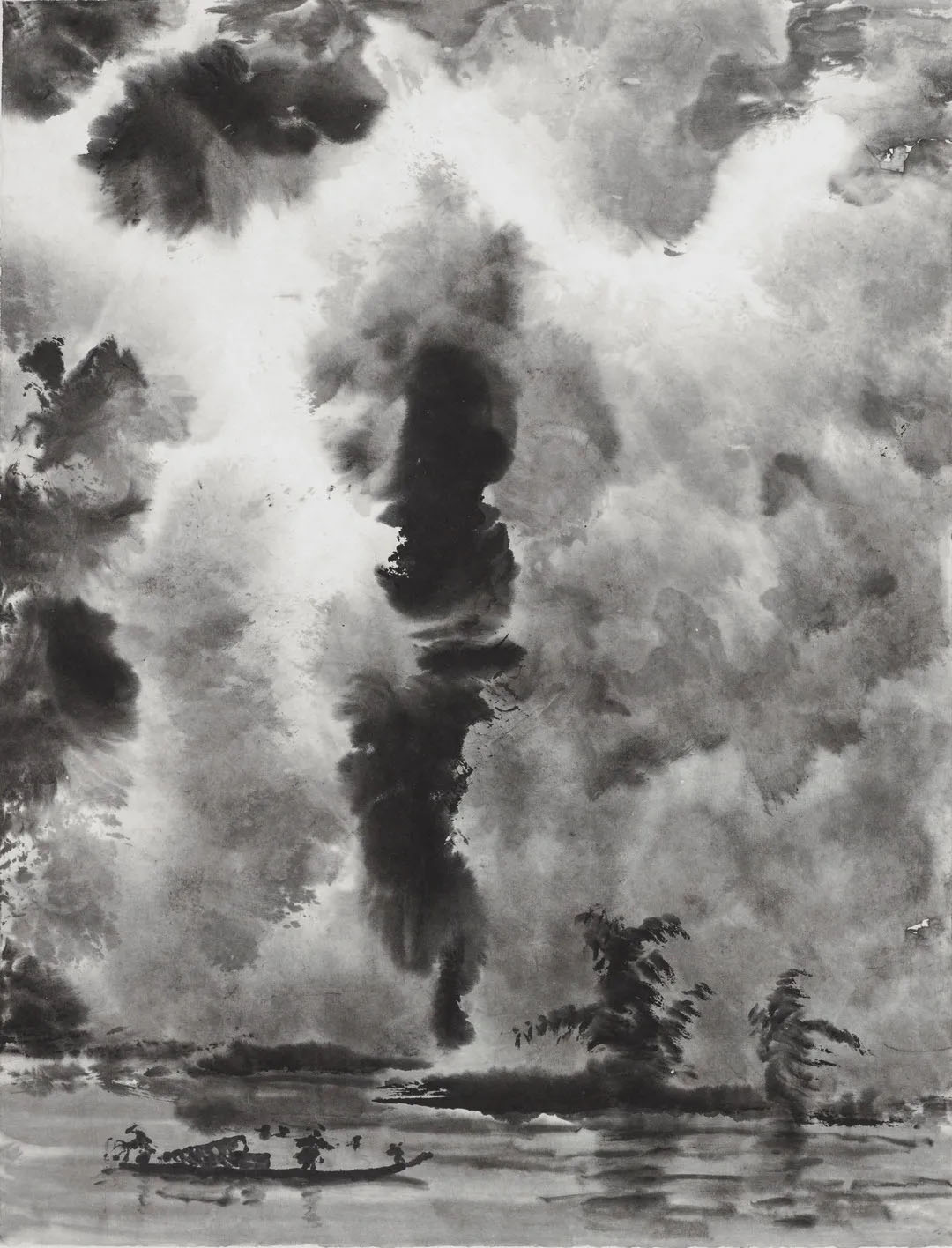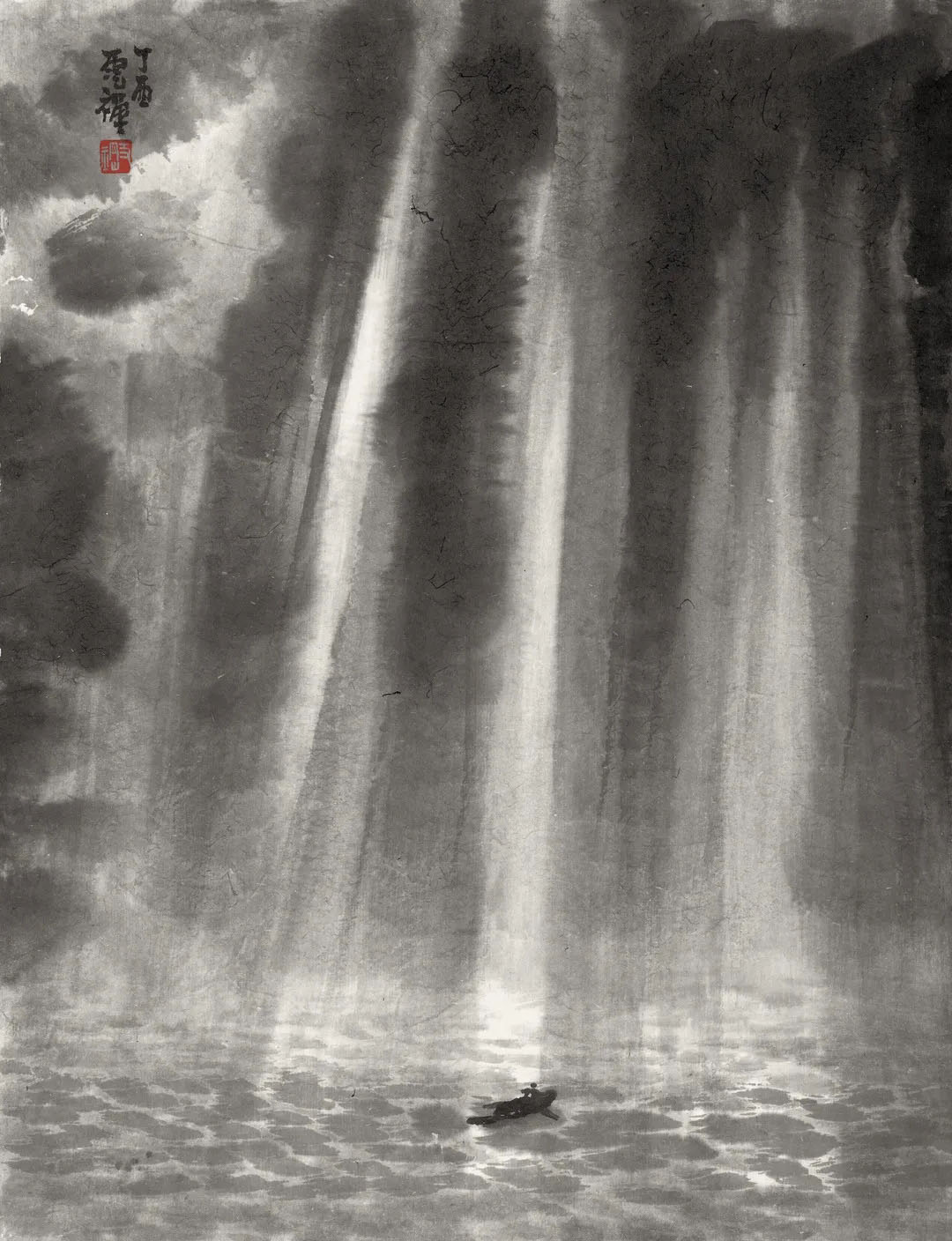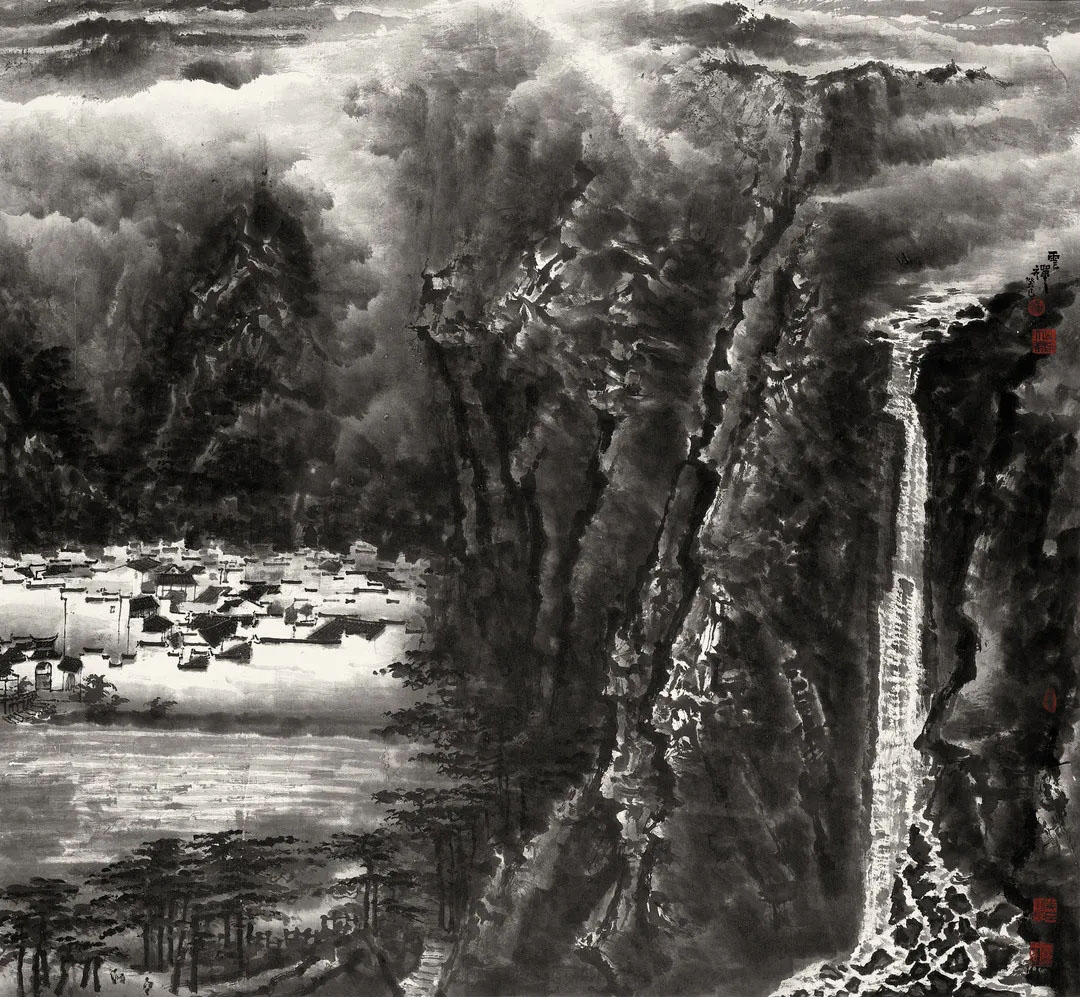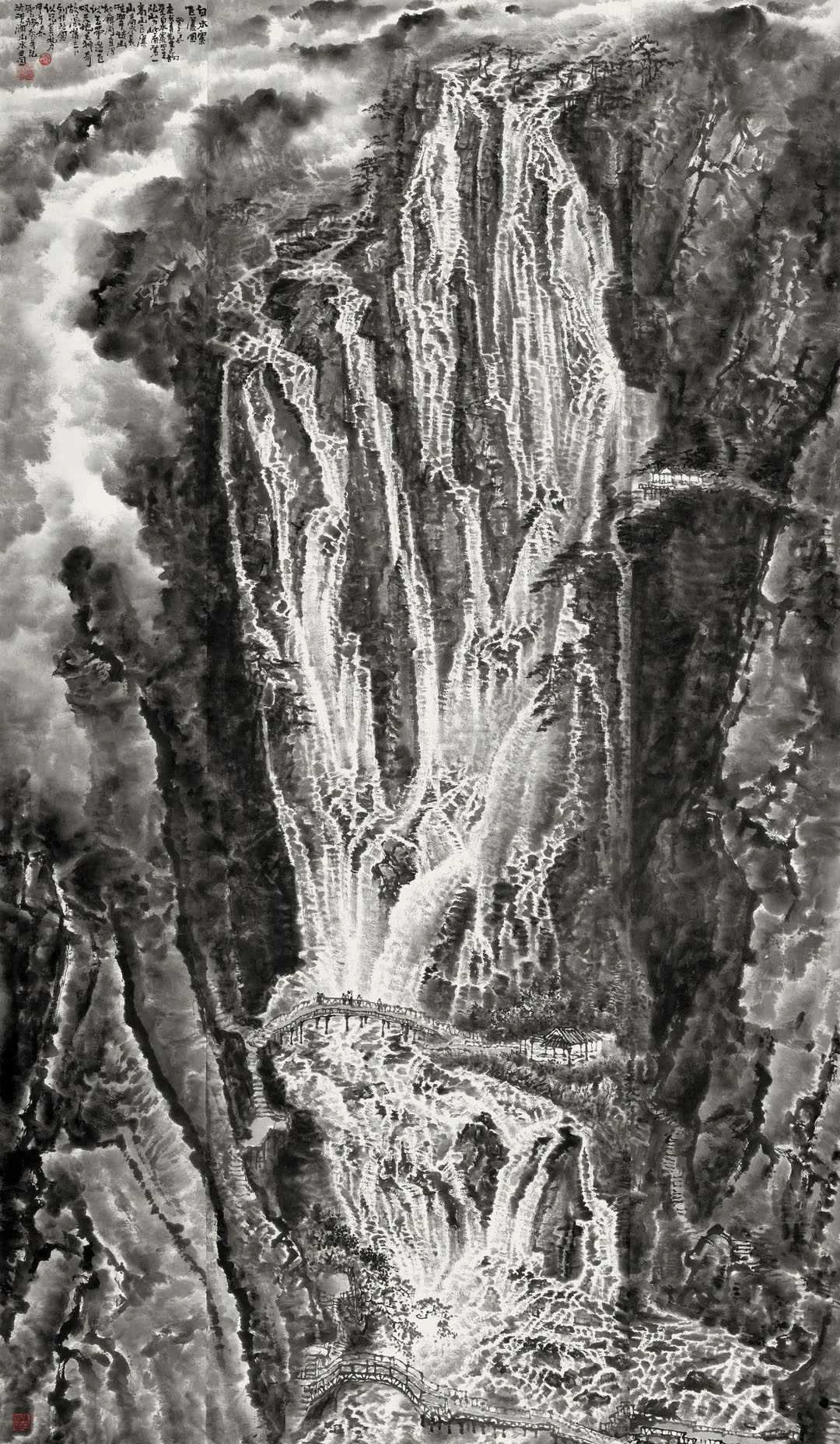- “Carry Forward the Undertakings of the Predecessors and Open up a New Road to the Future” Exhibition of Lai Zhigang’s Ink Art
- Home > > Exhibitions >
-
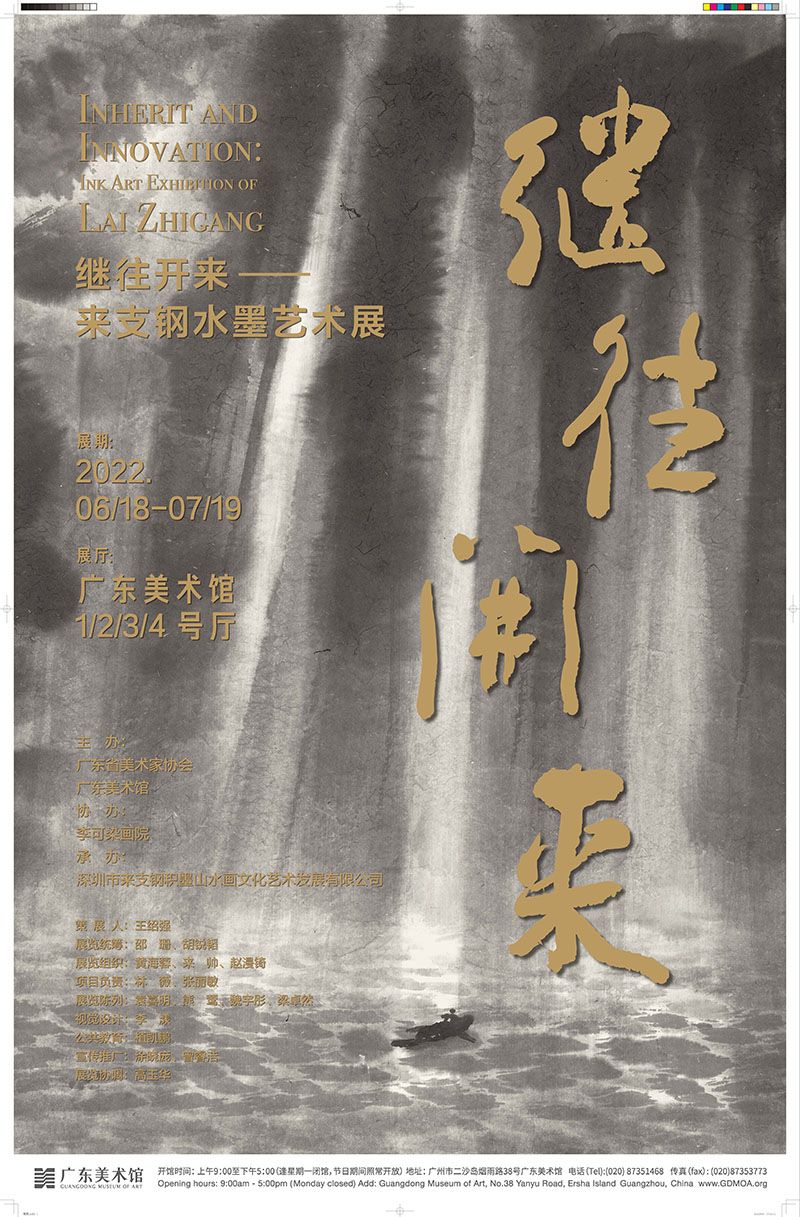
-
“Carry Forward the Undertakings of the Predecessors and Open up a New Road to the Future” Exhibition of Lai Zhigang’s Ink Art
Exhibition period: 2022-06-18 - 2022-07-19
Opening ceremony: 1690256565
Venue location: Guangzhou
Exhibition organization: Guangdong Art Museum
Exhibition organization: No. 38, Yanyu Road, Ersha Island, Baiyun Street, Yuexiu District, Guangzhou City, Guangdong Province
- Exhibition works
- VR exhibition
- Exhibition Introduction
Preface
Lai Zhigang has been fond of painting since he was a child, and has systematically studied Chinese landscape painting from Mr. Jia Youfu and Mr. Li Xiaoke. During his 40-year artistic journey, Lai persisted in exploring traditional accumulated-ink painting methods, absorbing the rich artistic essence from masters such as Mi Fu, Gong Xian, Huang Binhong, and Li Keran. By learning form the strengths of all the masters and integrating the past and the present knowledge, he finally came out with his unique painting style of "vigorous, strong and majestic".
In the Tang Dynasty, Wang Wei wrote at the beginning of The Essentials of Landscape Painting that "ink painting is the most ideal medium, as it draws from nature and depicts nature in the simplest way." According to legend, Chinese ink landscape painting began in the Tang Dynasty, gradually matured in the Five Dynasties, and was further popularized in the Song and Yuan Dynasties. After more than a thousand years, painters of all dynasties have summed up and accumulated rich experience in expressive techniques in the evolution and development of Chinese ink landscape painting. Huang Binhong believes that "in ink painting, inks of different shades and structures do not interfere with each other. What accumulated-ink technique requires is the color in the color and the ink in the ink." Accumulated-ink is a technical language of special importance in the history of ink painting. From light to thick, the layered ink shades has the characteristics of light but not thin, thick but not rigid, uniform but changeable, solid but layered. Benefiting from both his innate artistic talent and his personal creative passion, Lai, with his strong control over the picture, not only shows his solid foundation in the majestic images of mountains and water, but also is good at describing nature with exquisite artistic language.
In Lai Zhigang's large-scale landscape paintings such as The Way with Art, The Way of Clouds and The Rise, he used bold and unrestrained brushwork to depict overlapping mountains and rivers, with clouds and mist shrouding them. On the whole, these paintings show a majestic beauty and a strong sense of layering. Subtle ink color changes and ingenious blank spaces weave the virtual and the real, not only emphasizing the majestic and magnificent mountains and rivers, but also externalizing the myriad changes of nature in the painter's mind. Lai’s control over the brush and ink is flexible, with interwoven ink marks of different shades and touches and expressive lines with appropriate density to effectively control the texture and rhythm of the entire painting. There is a strong personal touch to Lai's ink paintings of clouds and water. In his masterpieces such as Spring Tide, Sage’s Domain, and The Great River Going East, what you see is not only mountains, clouds and water, but more like a collection of natural objects with similar momentum. This is a magnificent ink movement played by him in black and white language, which arouses the endless imagination of the viewers.
“Learn from nature and express yourself.” Lai Zhas a deep understanding of the traditional creative concepts of Chinese painting. He especially emphasizes sketching in nature, and his footprints are all over the country. Through unremitting practice and exploration, he gradually comprehended the Taoist thought contained in ancient landscape paintings, that is, art is the external expression of philosophy.
In the contemporary context of the diversified development of ink painting, we can see from Lai Zhigang's ink art how a diligent and down-to-earth artist inherits and sticks to the traditional techniques of brush and ink. We can feel the zeitgeist of sticking to the right path and innovating in his works.
President of Guangdong Art Museum Association
Vice Chairman of Guangdong Artists Association
Director of Guangdong Museum of Art
Wang Shaoqiang
June 2022
The Art of Interweaving the Virtual and the Real from Accumulation: "Real" and "Virtual” State in Lai Zhigang's Ink Landscape
Lai Zhigang's ink landscape contains two different appearances and atmospheres, one is "real state" and the other is "virtual state". What he pursues in the "real state" is the perfect and lifelike presentation of objective objects, which is imitative and realistic; while in the "virtual state", he has blurred the reality and raised it to the state of art. The "virtual state" expressed in his works may be a fragment or poeticization of the real state, or it may be a reversal or a symbol of the real state. In his ink and wash landscape paintings, the raw materials of the virtual state mostly come from the real state. Aided by intentional artistic techniques, he often creates aesthetic effects that are remote, hazy, ethereal, and resembling in spirit rather than in form through artistic language between the virtual and the real.
Lai's "real state" presents a kind of majestic beauty. In his large-scale works more than ten meters long, there are mountains stretching and clouds and fog rushing. The orderly brush and ink language contains a gushing wild power, conveying an irresistible inner impulse. Like the Qiantang River tide, they are whizzing across the river bank, colliding with waves of passion. This is a "real state", and Lai hopes to pursue a thick, steady, and powerful beauty through these images. In his "real state" works, Lai borrowed the panoramic views of the landscape paintings of the Northern Song Dynasty, but he did not adopt the characteristics of the natural scenery being close to people, but filled the picture with a religious and mysterious atmosphere. Such mysterious atmosphere comes from the serene consciousness he endows the painted objects and the corresponding artistic treatment. The steep mountains and cliffs constructed by the dense, complicated and hard ink lines did not leave the viewer with the spatial possibility that the landscape paintings of the Northern Song Dynasty emphasized, that is, they can be seen, stepped on, traveled, and lived in. Instead, Lai's sparsely vegetated cliffs constitute only a vast image. The turbulence of clouds in the mountains and valleys does not create a three-dimensional space for the viewer to travel; it just constitutes a formal interest in the conflict between motion and rest. In Lai's vision, the viewers should feel that they are not looking at the painting, but standing at the foot of the cliff and staring at the nature, until the hustle and bustle of the world disappears, leaving only the roar of the waterfall and the ethereal sound of the clouds
Lai Zhigang's landscape paintings with "real state" as the main body cast a solid and magnificent space. With their unique layout, grand imagery, fine composition and unique language of brush and ink, they show a state of harmony between man and nature, and even spiritual unity. Compared with the description of specific scenes, this painter prefers macroscopic expression in a symbolic sense. The vast layout of his ink lines seems to flow free from the shackles of physical space, and the mysterious symbols of mountains and rivers construct a picture of psychology and time that are constantly intertwined and moving, as well as a picture of a spiritual space waiting to resonate. On the visual level, Lai Zhigang's "real state" landscape creates a realm beyond the constraints of time and space, which is the unity of form and formlessness, order and disorder; On the auditory level, his "real state" landscape attracts viewers into a "big sound" that transcends the simple perception of sound. "Big sound" is a silent state that cannot be perceived through hearing. This kind of silence is a response to the sacred feeling, but Lai hopes that the viewer can hear the grand music like a symphony in the silent picture. This visual and auditory connection does not guide the viewer to experience the sacred existence through direct speech but through hints, allowing the viewer to feel the most sacred and mysterious moment in the mass in the silence. This is the "big sound" in Lai's mind, which can only be experienced in a certain state of silence or in a trance.
Lai describes a kind of ethereal beauty in the "virtual state". In his intertwined structures of soft water and ink, the images of moist mountains and water are erratic, illusory and dynamic, as if they are forever shrouded in rain and mist. As stated in “Biography of Ruan Ji” in The Book of Jin, such mountains and waters have an irresistible attraction. If we define Lai's majestic works as constructing a "virtual state" with a "real state", then his misty ink landscapes can be regarded as presenting a "real state" with a "virtual state".
For Lai, the real objects corresponding to Chinese landscape painting are neither the "real" related to the real world nor the "mirror image" of natural landscape. What he wants to express is the "virtual image" of nature that he extracted after comprehending nature. It is changeable, but it is always the embodiment of "virtual in reality" or "real in virtual". In his works with "virtual state" as the main body, we can vaguely recognize mountains, trees, clouds, water, figures and buildings in nature, but all of these are shrouded in smoke and mist, presenting a scene that has continued from ancient times to the present. The beauty of silence is just like the sky and the earth that are wordless and have no fixed form, but cannot be ignored. Lao Tzu once said, "Before the heaven and the earth appeared, there was only chaos," and this chaos "had no shape, no form that objects should have." More specifically, he believes that the image and state of the heaven, earth and all things regulated by Tao can be seen, but Tao itself cannot be directly perceived, which has no shape nor appearance. Consciously or unintentionally, Lai established the inner connection between ink painting and Chinese philosophy with his landscape paintings intertwined with "virtual" and "real". His ink landscapes are not constrained by specific objects, but integrate the emotions of the subject into the object, and use the invisible water to carry the ink to stack the shapes arbitrarily. This kind of brush-and-ink language and modern aesthetic expression, as well as the aesthetic demand for art to rise to the spiritual realm, silently transform the self-pursuit of the truth of life into a boundless and implicit transcendent artistic conception, and elucidates one's life experience of "virtual state" in the image of "real state".
Perhaps, in Lai's mind, the "real state" and the "virtual state" are both a "static" state. Stillness is an image that is invisible and intangible but can be perceived. Just as Wang Fuzhi said, the image of "quietness" is a transitional and relatively stable state between the transformation of form and formlessness. In Lai's "real state" and "virtual state" landscape paintings, the tangible objects are dyed with a hint of emotion and an atmosphere by his state of mind, which constitutes the transition state of the work from "quietness" to the tangible. As Sikong Tu said in the Tang Dynasty, “Only by returning to the emptiness and tranquility can one achieve the state of chaos, and only by accumulating righteousness can the heroic writing power be displayed. The majestic poem contains the momentum of all things, high and high across the vast space. Like the vast rolling clouds, like the mighty churning wind. Go beyond the superficial description of life and grasp the core content of the work. The pursuit of vigor cannot be based on forced collages, only what is naturally obtained will be meaningful.” In other words, the grandeur of Lai's "real state" landscape and the etherealness of "virtual state" landscape are both inspired and induced by the tangible image of mountains and rivers. The "virtual state" is inspired by the "real state", and the image inspired and extended by the "real state" has great initiative. Therefore, the viewer will feel that the subjective emotion has dyed the objective image of mountains and rivers with subjective colors, thus achieving the effect of the interweaving and mutual transformation of the virtual and the real in the painting.
Chinese landscape painting has a long history and rich tradition and cultural accumulation, but these inheritances have instead become obstacles in the creation of modern landscape painters. Therefore, we must first know that the key to inheritance is not to inherit the brush and ink techniques of the ancients, but to understand the spirit and state of mind of ancient landscape painters. The difference between landscape painting and painting in a broader sense is that Chinese landscape painting focuses on subjective composition and spiritual interpretation. It does not depict conventional pleasing scenery, but condenses the mountains and rivers in nature into a surreal landscape scene through the artist's subjective selection and arrangement. It emphasizes the release of the painter's state of mind, the pursuit of a poetic free state, and even a desire to get rid of the secular world. All in all, Chinese landscape painting is full of literary, ideal and philosophical qualities, and it is a visual "poetic" expression of Confucianism, Buddhism and Taoism. This kind of poeticity is concentrated in Sikong Tu's discussion on ancient poetic aesthetics and poetic theory, especially the aesthetics based on accumulation from the virtual state to the real state. Lai's ink landscape paintings focus on the interweaving of virtuality and reality through the layering and flow of ink colors, and finally return to a natural state. When he engages in landscape creation with this attitude and state of mind, he has already entered into a free spiritual space earlier than us. In this model, the natural landscape objects appearing as creative mediums truly and completely get rid of the constraints of time and space, and transform into the coexisting and independent "real state" and "virtual state" in Lai's works, presenting a connotation of landscape interwoven in the framework of ink and wash.
Perhaps, this is the deep aesthetic meaning of traditional charm and modern pursuit in Lai Zhigang's landscape paintings.
Luo Yiping
Deputy Director of the Curatorial Committee of the China Artists Association
Vice President of Guangdong Chinese Painting Society
Guests At the Opening Ceremony:
Lin Lan, Chairman of Guangdong Artists Association and President of Guangdong Academy of Painting
Wang Shaoqiang, Vice Chairman of Guangdong Artists Association and Director of Guangdong Art Museum
Pi Daojian, Deputy Director of the Curatorial Committee of the China Artists Association and Critic
Luo Dongkai, Former Deputy Director of the Organization Department of the Guangdong Provincial Party Committee and Former Secretary of the Provincial Working Committee
Xu Hongfei, Vice Chairman of Guangdong Artists Association and President of Guangzhou Sculpture Institute
Luo Yiping, Deputy Director of the Curatorial Committee of the China Artists Association
Song Lujing, Vice Chairman of Guangdong Artists Association and Vice President of Guangzhou Academy of Painting
Lu Zengkang, Member of the Presidium of Guangdong Artists Association and Vice President of Guangzhou Sculpture Garden
Sun Li, Member of the Oil Painting Art Committee of the China Artists Association, and Member of the Art Creation Committee of China's Major themes
Hu Ruitao, Deputy Director of Guangdong Museum of Art
Wen Chunqing, Chairman of Guangdong Hakka Chamber of Commerce and Chairman of Dabaihui Industrial Group
Wen Changqing, Chairman of Shenzhen Lai Zhigang Art Center
Lai Zhigang, the Artist of This Exhibition
Artist: Lai Zhigang
Curator: Wang Shaoqiang
Sponsor: Guangdong Artists Association
Guangdong Art Museum
Co-Organizer: Li Keran Painting Academy
Organizer: Shenzhen Lai Zhigang Accumulated-Ink Landscape Painting Culture and Art Development Co., Ltd.
Exhibition Remarks
Exhibition Hall: Hall 1/2/3/4, Guangdong Museum of Art
Exhibition Planning: Shao Shan, Hu Ruitao
Exhibition Organizer: Huang Hairong, Lai Shuai, Zhao Manqi
Project Leaders: Lin Wei, Zhang Limin
Exhibition Display: Yuan Ximing, Xiong Ying, Wei Yutong, Liang Zhuoran
Visual Design: Li Yang
Public Education: Zhi Kaipeng
Promotion: Tu Xiaopang, Zeng Ruijie
Exhibition Coordinator: Gao Yuhua
Opening Hours: 9:00 am to 5:00 pm (closed on Mondays, open as usual during festivals)

